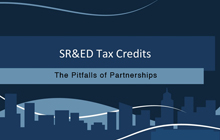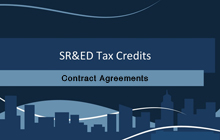Millions in SR&ED tax credits are being missed in overlooked industries by accountants

Real-world examples from Richard Hoy of claims that may surprise accountants looking for Scientific Research & Experimental Development tax credits
 |
Richard Hoy is president of specialist tax consultancy Catax Canada. |
CLAIMING tax credits for clients can present a minefield of obstacles.
The main tax incentive for research and development (R&D) in different industries is the Scientific Research and Experimental Development (SR&ED) program and it is awarded by the Canada Revenue Agency (CRA). There is strict criteria for claiming SR&ED that can be difficult to navigate in-house unless you have a dedicated role for monitoring qualifying activity.
As a result, it is often left to accounting firms to get to grips with activities that qualify for SR&ED. One of the stumbling blocks accountants first encounter is understanding whether their client is operating in an industry that sees a lot of investment through tax incentives.
Some industries have different rules governing how SR&ED is awarded, which can lead to projects being overlooked. Industries related to natural resources are some of the most frequently overlooked areas for claims. Successful claims can potentially contribute thousands of dollars to a project, so it is worth examining why these industries often miss out and why they are allowing this money to slip through the cracks.
Tax incentives in the oil and gas industry
SR&ED legislation specifically excludes claiming activities related to ‘prospecting, exploring or drilling for, or producing, minerals, petroleum or natural gas’. This is all considered field work carried out as part of business operations in the oil, gas and mining industries.
The wording in this headline exclusion may deter many companies in the sector from exploring a claim for SR&ED Investment Tax Credits. However, what some accountants may not know is that SR&ED is frequently found in supporting activities in the sector – for which claims may in fact be fully eligible.
There are some key areas of the industry that are more likely to be eligible for tax credits, including:
- The design and engineering of new systems or components used in the extraction and processing of natural resources.
- Developing components that overcome technological uncertainties in the industry.
- Technology that can be used to maintain the equipment used by the oil field services industry in Canada
We have worked with several companies in this sector to submit successful SR&ED claims, securing thousands of dollars in refundable tax credits.
A client that has seen multi-year success with their claims designs seals and thread protectors for use in harsh oil drilling environments. One misconception we often come across — even among accountants — is that companies working alongside a wider industry are mistakenly believed to fall under the same claims criteria. This client is an example of a company that manufactures components used by oil and gas companies but does not have to follow the exclusionary rules given to some aspects of innovation in the industry. These types of companies operating in a sub-sector are hugely overlooked, despite the high levels of innovation going on in many.
Meanwhile, another client we have worked with extensively is the BC-based SEI Logistics, a company that designs solar-powered lighting systems for use in remote, harsh outdoor environments. While most accountants will be aware that the renewable energy sector is a hotbed of innovation, the lines can become blurred when a company is directly supporting the oil and gas industry. In this case, our client was producing portable solar panels being used by oil, gas and mining companies in Northern and Western Canada that were not easily served by traditional forms of energy.
The Canadian energy industry is investing heavily in reducing carbon emissions; particularly with carbon capture and carbon sequestration technologies. This work does not fall under excluded activities for the purpose of claiming SR&ED.
Incentivizing alcohol production
The oil and gas sector isn’t the only industry we notice the CRA not prioritizing. Accountants may also find themselves working with clients not typically associated with being innovative. Companies in alcohol production are a good example, but are often ignored as they don’t fit the ‘lab coat’ image that is unfortunately linked to SR&ED claims.
Wineries are eligible because winemakers and vineyard managers often employ innovative techniques and methods to produce better, or more unique wines. The wine industry in Canada is constantly growing and it is in the economic interests of the federal government to promote innovation in the sector. Tax credits have also been awarded to wineries managing the specific challenges of their unique climate, soil or irrigation needs across the country.
One winery that a Catax client had started working with a special natural yeast. The challenge was identifying and protecting the attributes of the yeast and working with research partners to find the best way to commercialize its uniqueness.
What can accountants do to help their clients?
Understanding how your client's activities relate to the complex requirements placed on SR&ED claimants is the first, and most difficult hurdle to cross when it comes to exploring how this tax incentive can benefit your client. If you are unsure if it is relevant to the work they are doing, it may be worth consulting with a SR&ED specialist.
Above all, the success or failure of a claim often depends on how easy it is to prove that the work is eligible. This means that your clients should be made aware of the evidence that is usually required, including the importance of record-keeping.
Accountants may currently be working with their clients as they recently finished their corporate year end, meaning that now is the time to be assessing what activity may or may not qualify. The legislation governing how SR&ED is delivered is meant to be inclusive and relevant to a multitude of different industries. There is always a chance that your client is carrying out work that would qualify, so long as you know how to identify when it is present.
Richard Hoy is president of specialist R&D tax incentive consultancy Catax Canada. Accountants interested in partnering with Catax to assist their clients can find out more by emailing Richard at Richard.Hoy@catax.com.










(0) Comments